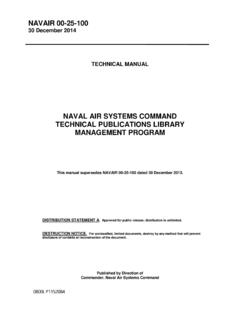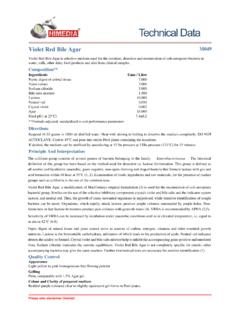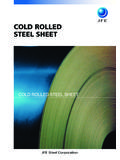Transcription of CHLORFENAPYR (254) - Food and Agriculture Organization
1 CHLORFENAPYR 181 CHLORFENAPYR (254) First draft prepared by Mr David Lunn, Dr Dugald MacLachlan and Dr Weili Shan Ministry of Agriculture , Forestry and Fisheries, Wellington, New Zealand Department of Agriculture , Fisheries and Forestry, Canberra, Australia Institute for the Control of Agrochemicals, Ministry of Agriculture , Beijing, China EXPLANATION The CHLORFENAPYR is a pro-insecticide-miticide. Its biological activity depends upon its activation to another chemical (CL303268). Oxidative removal of the N-ethoxymethyl group of CHLORFENAPYR by mixed function oxidases forms CL303268. This compound uncouples oxidative phosphorylation at the mitochondria, resulting in the disruption of ATP production, cellular death, and ultimately organism mortality. CHLORFENAPYR is used as an insecticide-miticide on a number of fruits, vegetables, grains, herbs, spices and tea. At the Forty-third session of CCPR it was scheduled for evaluation by the 2012 JMPR as a new compound.
2 The manufacturer provided information on identity, metabolism, storage stability, analytical methods, use patterns, residue trials on citrus fruit, papaya, bulb vegetable, fruiting vegetables (melon, squash, cucumber), tomato, eggplant, pepper, potato, carrot and tea, and processing studies and livestock feeding studies. IDENTITY ISO common name: CHLORFENAPYR Chemical name IUPAC: 4- bromo-2-(4-chlorophenyl)-1-(ethoxymethyl )-5-(trifluoromethyl)-1H-pyrrole-3-carbo nitrile CAS: 4- bromo-2-(4-chlorophenyl)-1-ethoxymethyl- 5-(trifluoromethyl)-1H-pyrrole-3-carboni trile CAS number: 122453-73 0 CIAPC No.: 570 Manufacture code No.: BAS 306 I Structural formula Molecular formula: C15H11 BrClF3N2O Molecular mass: 182 CHLORFENAPYR PHYSICAL AND CHEMICAL PROPERTIES Pure active ingredient, minimum purity Parameter Result References Guidelines Vapour Pressure 10-8 mm Hg [20 C] a CK-306-002 EC Annex V method 10-6 Pa [25 C] b 10-8 mm Hg [25 C] [calculation based on 60, 70, 80 C] CK-306-003 EC Annex V method USEPA OPP 63 - 9 Melting point - C a CK-303-002 EC Annex V method OECD 102 Octanol/water partition coefficient Pow = 105 (log Pow = ) (20 C) a CK-315-002 OECD method 107 Solubility in buffer: pH 5: mg/L [20 C] a pH 7: mg/L [20 C] pH 9: mg/L [20 C] in deionized water.
3 A mg/L [10 C] mg/L [20 C] mg/L [30 C] CK-311-001 EC Annex V method in organic solvents at 15 to 25 C a acetone 133 g/100 mL acetonitrile g/100 mL dichloromethane 169 g/100 mL ethyl acetate g/ 100 mL hexane g/100 mL methanol g/100 mL toluene g/100 mL CK-311-001 EC Annex V method Hydrolysis in water stable to hydrolysis at 50 C in pH 4, 7 and 9 buffer over 5 days a CK-322-006 OECD method 111 Quantum yield of direct photo-transformation the mean quantum yield( x) = 10-2 10-2 the transformation after 45 minutes (at 290 8 nm, at 20 1 C in a 50:50 (v/v) mixture of acetonitrile and purified deionized water ) ranged between 8% and 16% b CK-630-006 OECD guideline: Phototransformation of Chemicals in Water, Part A, Direct Phototransformation BBA guideline: Part IV/6 - 1, Stage UV/VIS max = 260 nm (acetonitrile) a max = 10751 M-1 cm-1 CK-360-001 UV spectroscopy a Purity b Purity Technical material, minimum purity Parameter Result References Guidelines Appearance light tan to light yellow powder a also odour typical of ketones C-301-001 ASTM D1535 - 80 USEPA OPPTS USEPA OPPTS ASTM D1292 - 86 USEPA OPPTS Odourless white with pale yellow tint powder CK-301-002 ASTM D1292 - 86 USEPA OPPTS ASTM D1535 - 68 USEPA OPPTS USEPA OPPTS CHLORFENAPYR 183 Parameter Result References Guidelines Boiling point Decomposes before boiling a c CK-334-001 EC Annex V method Decomposition Temperature 183 C, onset of decomposition a c CK-334-001 USEPA OPPTS bulk density g/cm3 [24 C] (untapped) a g/cm3 [24 C] (tapped) a C-301-001 CIPAC MT 33 g/cm3 [20 C] b CK-301-002 CIPAC MT 33 Vapour pressure < 10-5 Pa [20 C] d CK-306-002 EC Annex V method Solubility in water in buffer c.
4 PH 4: mg/L [25 C] pH 7: mg/L [25 C] pH 10: mg/L [25 C] in deionized water: mg/L [25 C] CK-310-001 USEPA OPP 63 - 8 Solubility in organic solvents at 15 to 25 C acetone 114 g/100 mL acetonitrile g/100 mL dichloromethane 141 g/100 mL hexane g/100 mL methanol g/100 mL toluene g/100 mL c CK-310-001 USEPA OPP 63 8 n-Octanol/water partition coefficient Pow = 104 (log Pow = ) (20 C) e CK-315-001 USEPA OPP 63 11 Hydrolysis rate stable to hydrolysis at 25 C in pH 5, 7 and 9 buffer over 30 days f CK-322-005 USEPA OPP 161 - 1 Photochemical degradation CHLORFENAPYR is rapidly photolysed in water a f t = days (pH 5) (average) t = days (pH 7) (average) t = days (pH 9) (average) CK-630-003 USEPA OPP 161 Surface tension solution: mN/m [20 C] 1% solution: 723 mN/m [20 C] g 2003/1009390 EC Annex V method pH in 1% aqueous suspension [24 C] a C-301-001 OTS CG - 1450 (1982) ASTM E70 - 74 Henry's law constant (calculation) H = < 10-7 atm*m3/g*mole CK-390-001 KH = 10-3 Pa*m3/mole [20 C] KH = 10-6 (dimensionless) [20 C] 2003/5000483 a Purity b Purity c Purity d Purity e Purity f Purity g Purity 184 CHLORFENAPYR Formulation CHLORFENAPYR is commercially marketed as suspension concentrate (SC 100 g/L, 240 g/L and 360 g/L) and emulsifiable concentrate (EC 100 g/L) formulations.
5 Specification An FAO specification for CHLORFENAPYR has not been established by the JMPS under the new system. METABOLISM AND ENVIRONMENTAL FATE Metabolism and fate studies in livestock, Agriculture crops and soil were carried out with [phenyl (U)-14C] CHLORFENAPYR and [pyrrole-14C] CHLORFENAPYR (see Figure 1). [Phenyl ( U) 14C] CHLORFENAPYR [Pyrrole 14C] CHLORFENAPYR Figure 1 Label position of 14C CHLORFENAPYR , marked as * (phenyl) or + (pyrrole), used in metabolism studies Metabolites are given various abbreviations and code numbers in the studies. Abbreviations and codes, chemical names, and structures are shown in Table 1, along with information on the matrices in which the particular compound was found. Table 1 Metabolites of CHLORFENAPYR in animal, plant, soil and water/sediment Code Metabolite No Chemical name Chemical Structure Matrices M-9 CL303630 CHLORFENAPYR 4-bromo-2-(4-chlorophenyl)-1-(ethoxymeth yl)-5-(trifluoromethyl)-pyrrole-3-carbon itrile Animals Plants Soil CL303267 2-(4-chlorophenyl)-5-(trifluoromethyl)-1 H-pyrrole-3-carbonitrile Plants, Soil CL303268 4-bromo-2-(p-chlorophenyl)-5-(trifluorom ethyl)-pyrrole-3-carbonitrile Animals Plants Soil CL357806 Regioisomer of CHLORFENAPYR 2-bromo-4-(4-chlorophenyl)-1-(ethoxylmet hyl)-5-(trifluoromethyl)-pyrrole-4-caibo nitrile Waters NBrCNF3 CCH2 OCH2CH3 ClNCNF3 CHClNBrCNF3 CHClNCNF3 CCH2 OCH2CH3 ClBr CHLORFENAPYR 185 Code Metabolite No Chemical name Chemical Structure Matrices M-3(B) CL152833 deschlorodihydroxyphenyl-CL303268.
6 Animals M-4 CL152837 4-hydroxy-2-(p-chlorophenyl)-5-(carboxyl ic)- pyrrole-3 -carbonitrile a hydroxylated CL303268 metabolite Animals M-5 CL325195 2-(4-chlorophenyl)-5-hydroxyl-4-oxo-5-(t rifluoromethyl)-3-pyrrole-3-carbonitrile Animals Plants Soil M-5A CL322250 4-bromo-2-(p-chlorophenyl)-5-(carboxylic )- pyrrole-3-carbonitrile Animals Plants M-6 CL152835 desbromo-N-carboxymethylmethoxy BAS 306 I Animals M-6A CL325157 {[3-bromo-5-(p-chlorophenyl)-4-cyano-2-( trifluoromethyl) pyrrol-1-yl]methyl}- acetic acid Animals M-7 CL152834 hydroxyphenyl CL303268 Animals M-7A CL152832 destrifluoromethyl CL303268 Animals M-8A CL312094 2-(4-chlorophenyl)-1-(ethoxymethyl)-5-(t rifluoromethyl) -1H-pyrrole-3-carbonitrile Animals Plants Soil CL152836 2-(4-chlorophenyl)-1-(2-hydroxy-ethoxyme thyl)-5-(trifluoromethyl) -1H-pyrrole-3-carbonitrile Animals CL312571 2-bromo-4-(4-chlorophenyl)- 5-(trifluoromethyl)-1H-pyrrole-3-carboni trile Plants NBrCNF3 CHOHOHNHOCNHOOCHClNOCNHClF3 CHONBrCNHOOCHClNCNF3 CCH2 OCH2 COOHClNCNF3 CCH2 OCH2 COOHClBrNBrCNF3 CHClOHNBrCNHClNCNF3 CCH2 OCH2CH2 OHCl186 CHLORFENAPYR Code Metabolite No Chemical name Chemical Structure Matrices M-10 Unknown Animals Animal metabolism The Meeting received information on the fate of 14C- CHLORFENAPYR in the lactating goats and laying hens.
7 Studies were carried out with [14C]- CHLORFENAPYR , labelled at the phenyl or pyrrole ring. Metabolism in laboratory animals (rat) was summarised and evaluated by the WHO panel of the 2012 JMPR. Lactating goat Zulalian (1994 CK-440-004) studied the metabolism of [14C]- CHLORFENAPYR in lactating goats. Four lactating goats (3 Lamancha and one Nubian cross; kg bw), two per label, were dosed via capsules with [14C]- CHLORFENAPYR for seven consecutive days at the equivalent of and 18 ppm feed for [phenyl-U-14C] CHLORFENAPYR and and 16 ppm for [2-pyrrole-14C]- CHLORFENAPYR . Feed consumption was 2 kg/day, milk production was l/day. During the treatment period, milk, urine and faeces were collected daily. At sacrifice (within 22 hours after the last dose) samples of liver, kidney, muscle and fat were collected. The major route of elimination of the radioactivity was via the faeces which accounted for to of the administered dose; while urine accounted for to of the administered dose.
8 The distribution of the TRR in milk and tissues from both labels was similar. In the high dose group, the TRR in milk increased from to mg eq/kg by day 7 while 14C residues in tissues ranged from mg eq/kg in muscle to mg eq/kg in liver. Recovery of administered radioactivity ranged from 81 to 90% for the various doses and labels. Milk residues plateaued by 4 to 5 days of dosing while residues in blood continued to increase during the course of the study. Table 2 14C residues in blood and milk of goats dosed with [phenyl-U-14C] CHLORFENAPYR or [2-pyrrole-14C]- CHLORFENAPYR Days of TRR (mg/kg as CHLORFENAPYR ) dosing [phenyl-U-14C]- CHLORFENAPYR [2-pyrrole-14C]- CHLORFENAPYR [phenyl-U-14C]- CHLORFENAPYR [2-pyrrole-14C]- CHLORFENAPYR ppm ppm 18 ppm 16 ppm Blood Milk Blood Milk Blood Milk Blood Milk Pre-dosing < < < < < < < < 1 2 3 4 5 6 7 Extractability of 14C residues from liver and kidney using methanol was low at 19 23% for liver and 16 20% for kidney.
9 Solvent extractability for fat (acetonitrile) and milk (methylene chloride) was 76 95% for fat and 88 92% for milk. CHLORFENAPYR 187 Table 3 Characterisation of 14C residues in tissues and milk of goats dosed with [phenyl-U-14C] CHLORFENAPYR or [2-pyrrole-14C]- CHLORFENAPYR TRR Extract a (%TRR) PES TRR Extract (%TRR) PES (mg eq/kg) hexane ACN/MeOH/H2O H2O (%TRR) (mg eq/kg) hexane ACN/MeOH/H2O H2O (%TRR) [phenyl-U-14C] CHLORFENAPYR ppm 18 ppm Liver 10 - - Kidney - 80 - Muscle - NP NP - 68 Fat - - Milk NP NP NP NP 2 [2-pyrrole-14C]- CHLORFENAPYR ppm 16 ppm Liver 7 - 4 15 - 81 Kidney 8 - - Muscle NP NP - - 52 Fat - - 5 Milk NP NP NP NP a 14C residues extracted with methanol from liver, kidney and muscle, acetonitrile from fat and methylene chloride from milk after first precipitating proteins with methylene chloride and acetone.
10 The tissue solvent extracts were partitioned with solvents systems in table above. NP = not processed. CHLORFENAPYR was the major component of the 14C residues in milk (25 68% TRR), fat (47 78% TRR) and muscle (29 52% TRR). Other major 14C residue components were CL303268 in fat ( 19% TRR) Metabolism was more extensive in liver and kidney and in these tissues CHLORFENAPYR represented less than 7 and 10% TRR respectively. Table 4 Combined results for the characterization and identification of the [phenyl-U-14C]- CHLORFENAPYR derived residues in lactating goats from and 18 ppm feed levels ppm 18 ppm Liver Kidney Muscle Fat Milk Liver Kidney Muscle Fat Milk TRR (mg eq/kg) Component %TRR Extract a a a a - b c - a a Unidentified fraction 1 Unidentified fraction 2 ND < Sulphate conjugates d d Unidentified fraction 4 < CL325195 CL322250 < AC8805-31-2-B AC8944-45 < 11 AC8508-33-B1 CL303268 CHLORFENAPYR Unidentified fraction 10 ND ND ND ND ND ND Unidentified fraction 11 < ND < ND a portion of 14C in methanol extract that partitioned into acetonitrile/methanol/H2O b sum of portions of 14C in methanol extract that partitioned into acetonitrile/methanol/H2O and into hexane c sum of portions of 14C in methanol extract that partitioned into acetonitrile/methanol/H2O, hexane hydrolysis and 14C released on hydrolysis of PES d sulphate conjugates of CL322250 (AC8508.)

















